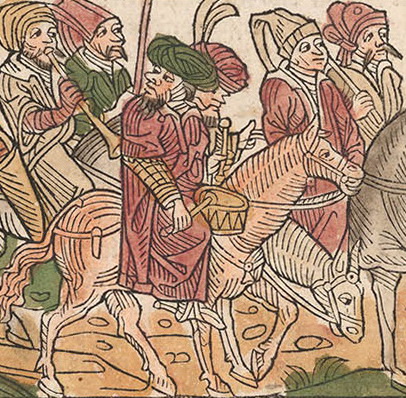Peregrinationes in terram sanctam by Bernhard von Breidenbach
Peregrinationes in terram sanctam by Bernhard von Breidenbach
There is never a pilgrim who returns home without one less prejudice and one new idea.
Thomas Morus
Bernhard von Breidenbach (1440-1497), canon of Mainz, departed on a pilgrimage to Jerusalem in 1483. He motives were not solely religious; he also had the idea of writing a guidebook for pilgrims to the Holy Land. He was accompanied on the dangerous and uncomfortable journey by the artist Erhard Reuwich and four other men, one of whom died on the way. After his return in 1484, Breidenbach, in cooperation with Martin Roth, a professor of theology, wrote the manuscript of the very first pilgrims' guidebook. In the book he described the ports of call on the sea voyage from Venice to Jaffa, the holy places and the customs of the peoples there. He even added an Arabic-Latin vocabulary. Reuwich made a contribution of 28 woodcuts. The woodcuts, some of which are on folded oversized pages (up to 26 x 162 centimetres in size), show detailed views of the city, people and animals of the different regions as well as oriental alphabets. They were models in their craftsmanship for, among others, the woodcuts of Pleydenwurff and Wolgemut in Schedel’s World Chronicle (Schedelsche Weltchronik) (1493).
The Peregrinatio in terram sanctam (Pilgrimage to the Holy Land) appeared in 1486, printed by Reuwich with the Schwabacher typeface and type material from Peter Schöffer’s workshop. German and Dutch editions followed in the same year. The Deutsches Buch- und Schriftmuseum owns a reprint, which Anton Sorg published in Augsburg in 1488 under the title Die fart oder reysz über mere zu dem heylige[n] grab vnsers herren Jhesu cristi gen Jherusalem (The voyage or journey across the sea to Jerusalem to the holy grave of our lord Jesus Christ). It contains eight illustrations. The large folded woodcuts of the first edition were not included; it was clearly too expensive to reproduce them.

